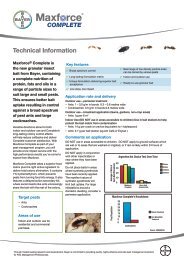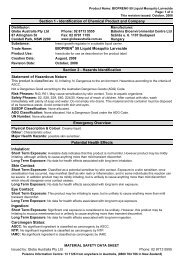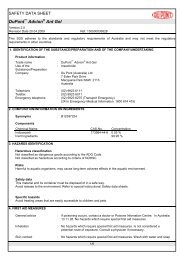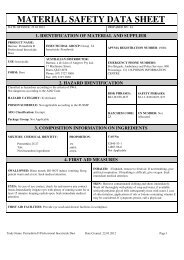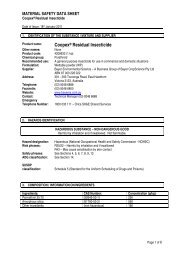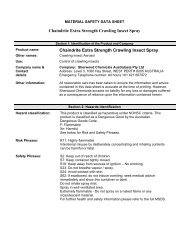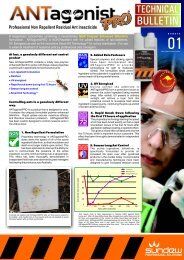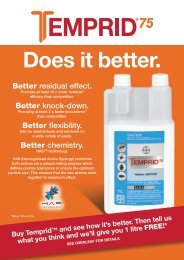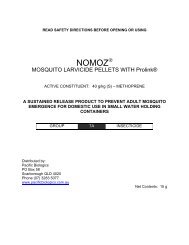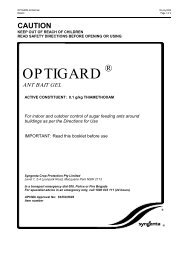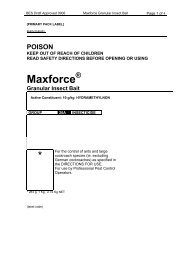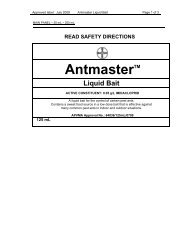BIFORCE® 200SC WATER-BASED Termiticide ... - Globe Australia
BIFORCE® 200SC WATER-BASED Termiticide ... - Globe Australia
BIFORCE® 200SC WATER-BASED Termiticide ... - Globe Australia
Create successful ePaper yourself
Turn your PDF publications into a flip-book with our unique Google optimized e-Paper software.
Label<br />
POISON<br />
KEEP OUT OF REACH OF CHILDREN<br />
READ SAFETY DIRECTIONS BEFORE OPENING OR USING<br />
<strong>BIFORCE®</strong> <strong>200SC</strong><br />
<strong>WATER</strong>-<strong>BASED</strong><br />
<strong>Termiticide</strong> & Insecticide<br />
ACTIVE CONSTITUENT: 200g/L BIFENTHRIN<br />
GROUP 3A INSECTICIDE<br />
For pre-construction and post-construction<br />
management of Subterranean Termites and for the control<br />
of a range of other urban pests both indoors and outdoors as<br />
specified in the Directions For Use.<br />
IMPORTANT:<br />
RESTRICTED CHEMICAL PRODUCT ONLY TO BE SUPPLIED TO,<br />
OR USED BY AN AUTHORISED PERSON<br />
IMPORTANT:<br />
READ THE ATTACHED LEAFLET BEFORE OPENING OR USING<br />
CONTENTS: 1L, 5L, 10L, 200L<br />
Distributed by;<br />
Sherwood Chemicals Australasia Pty Ltd<br />
Level 3, 1060 Hay Street<br />
WEST PERTH 6005<br />
AUSTRALIA<br />
T: +61 89219 4683<br />
F: +61 89219 4672<br />
<strong>BIFORCE®</strong> is a registered Trademark of SHERWOOD CHEMICALS PUBLIC COMPANY LTD, THAILAND<br />
<strong>BIFORCE®</strong> <strong>200SC</strong> <strong>WATER</strong>-<strong>BASED</strong> <strong>Termiticide</strong> & Insecticide APVMA No. 64877 1,5,10,200 Litre Label<br />
7th December 2011 Version: 3 Page 1 of 3
CONDITIONS OF USE BY AUTHORISED PERSONS<br />
The Pest Control Operator must be licensed under state legislation.<br />
For pre-construction termite treatments, the Pest Control Operator must notify site supervisor, if any, and workers who<br />
come into contact with uncovered treated soil prior to laying the moisture membrane, to wear appropriate personal<br />
protective equipment and to observe re-entry requirements. (For personal protective equipment, refer to “SAFETY<br />
DIRECTIONS”, and for re-entry refer to “PRECAUTIONS RE-ENTRY PERIODS” below).<br />
PRECAUTIONS AND RE-ENTRY PERIODS<br />
DO NOT spray into the air or directly on humans, pets or animals. Avoid contact with food, food utensils or preparation<br />
surfaces.<br />
Re-entry period<br />
Pre-construction: Re-entry - DO NOT allow entry into uncovered treated areas until the spray has dried. When prior<br />
entry is necessary, wear cotton overalls buttoned to the neck, wrist and elbow–length PVC, neoprene or nitrile gloves<br />
and chemical resistant footwear. Clothing must be laundered after each day’s use.<br />
Post-Construction and urban pest control: Re-entry DO NOT allow people and pets to enter treated areas until the<br />
spray has dried. When prior entry is necessary, wear cotton overalls buttoned to the neck, wrist and elbow–length PVC,<br />
neoprene or nitrile gloves and chemical resistant footwear. Clothing must be laundered after each day’s use.<br />
STORAGE, SPILLAGE AND DISPOSAL<br />
Store in closed original container, in a cool, well-ventilated area away from children, animals, food and feedstuffs. DO<br />
NOT store for prolonged periods in direct sunlight. In case of spillage, confine and absorb spilled product with absorbent<br />
material such as sand, clay or cat litter. Dispose of waste as indicated below or according to the <strong>Australia</strong>n Standard AS<br />
2507 – Storage and Handling of Pesticides. DO NOT allow spilled product to enter sewers, drains, creeks or any other<br />
waterways.<br />
For REFILLABLE containers: Empty contents fully into application equipment. Close all valves and return to point of<br />
supply for refill or storage.<br />
For 1 L, 5 L, 10L Containers<br />
Triple or preferably pressure rinse containers before disposal. Add rinsings to spray tank. DO NOT dispose of undiluted<br />
chemicals on-site. If recycling, replace cap and return clean containers to recycler or designated collection point. If not<br />
recycling, break, crush or puncture and bury empty containers in a local authority landfill. If no landfill is available, bury<br />
the containers below 500 mm in a disposal pit specifically marked and set up for this purpose clear of waterways,<br />
vegetation and tree roots. Empty containers and product should not be burnt. DO NOT bury waste or surplus product.<br />
Dispose of undiluted waste by either dilution and use according to the Directions for Use or returning to the point of<br />
purchase in the original container for controlled disposal. Dispose of diluted surplus product by using according to the<br />
Directions for Use. DO NOT re-use empty container.<br />
Envirodrum (200L)<br />
Store the original sealed Envirodrum in a cool well-ventilated area. DO NOT store for prolonged periods in direct<br />
sunlight. DO NOT tamper with the Micro Matic valve or the security seal. DO NOT contaminate the Envirodrum with<br />
water or any foreign matter. After each use of the product, please ensure that the Micro Matic coupler delivery system<br />
and hoses are disconnected, triple rinsed with clean water and drained accordingly. When the contents of the<br />
Envirodrum have been used, please return the Envirodrum to the point of purchase. The Envirodrum remains the<br />
property of Sherwood Chemicals.<br />
<strong>BIFORCE®</strong> <strong>200SC</strong> <strong>WATER</strong>-<strong>BASED</strong> <strong>Termiticide</strong> & Insecticide<br />
APVMA No.<br />
1,5,10,200 Litre Label<br />
64877<br />
7th December 2011 Version 3 Page 2 of 3
SAFETY DIRECTIONS<br />
Poisonous if swallowed. Will irritate the eyes and the skin.<br />
Repeated exposure may cause allergic disorders. Avoid contact with eyes and skin.<br />
When opening container, mixing and loading and preparing the spray, wear cotton overalls buttoned to the<br />
neck and wrist, a washable hat, elbow-length chemical resistant gloves, face shield or goggles and chemical<br />
resistant footwear.<br />
When using prepared spray, wear cotton overalls buttoned to the neck and wrist, a washable hat and elbowlength<br />
chemical resistant gloves.<br />
When using in enclosed areas, wear cotton overalls buttoned to the neck and wrist, a washable hat, elbowlength<br />
chemical resistant gloves and half-face respirator with the combined dust and gas cartridge.<br />
If product in eyes wash it out immediately with water.<br />
After use and before eating, drinking or smoking, wash hands, arms and face thoroughly with soap and water.<br />
After each day’s use, wash gloves, face shield or goggles, respirator (if rubber wash with detergent and warm<br />
water) and contaminated clothing.<br />
FIRST AID<br />
If poisoning occurs, contact a doctor or Poisons Information Centre. Phone <strong>Australia</strong> 13 11 26. If swallowed do NOT induce<br />
vomiting. Give a glass of water. If skin contact occurs, remove contaminated clothing and wash skin thoroughly.<br />
MATERIAL SAFETY DATA SHEET.<br />
Additional information is listed in the Material Safety Data Sheet (MSDS). A Material Safety Data Sheet for<br />
<strong>BIFORCE®</strong> <strong>200SC</strong> <strong>WATER</strong>-<strong>BASED</strong> TERMITICIDE & INSECTICIDE is available from Sherwood on request. Call<br />
Customer Service on 0421 667 972<br />
CONDITIONS OF SALE:<br />
The use of <strong>BIFORCE®</strong> <strong>200SC</strong> <strong>WATER</strong>-<strong>BASED</strong> TERMITICDE & INSECTICDE being beyond the control of the<br />
manufacturer, no warranty expressed or implied is given by Sherwood Chemicals., regarding its suitability, fitness or<br />
efficiency for any purpose for which it is used by the buyer, whether in accordance with the directions or not and<br />
Sherwood Chemicals accepts no responsibility for any consequence whatsoever resulting from the use of this product.<br />
Batch No:<br />
Date of Manufacture:<br />
APVMA Approval No. 64877/1L/1211<br />
APVMA Approval No. 64877/5L/1211<br />
APVMA Approval No. 64877/10L/1211<br />
APVMA Approval No. 64877/200L/1211<br />
<strong>BIFORCE®</strong> <strong>200SC</strong> <strong>WATER</strong>-<strong>BASED</strong> <strong>Termiticide</strong> & Insecticide<br />
APVMA No.<br />
1,5,10,20,200 Litre Label<br />
64877<br />
7th December 2011 Version 3 Page 3 of 3
Leaflet<br />
POISON<br />
KEEP OUT OF REACH OF CHILDREN<br />
READ SAFETY DIRECTIONS BEFORE OPENING OR USING<br />
<strong>BIFORCE®</strong> <strong>200SC</strong><br />
<strong>WATER</strong>-<strong>BASED</strong><br />
<strong>Termiticide</strong> & Insecticide<br />
ACTIVE CONSTITUENT: 200g/LBIFENTHRIN<br />
GROUP 3A INSECTICIDE<br />
For pre-construction and post-construction<br />
management of Subterranean Termites and for the control<br />
of a range of other urban pests as specified in the<br />
Directions For Use.<br />
IMPORTANT:<br />
RESTRICTED CHEMICAL PRODUCT ONLY TO BE SUPPLIED TO,<br />
OR USED BY AN AUTHORISED PERSON.<br />
IMPORTANT:<br />
READ THE LEAFLET BEFORE OPENING OR USING<br />
Distributed by;<br />
Sherwood Chemicals Australasia Pty Ltd<br />
Level 3, 1060 Hay Street<br />
WEST PERTH 6005<br />
AUSTRALIA<br />
T: +61 89219 4683<br />
F: +61 89219 4672<br />
BIFORCE ® is a registered Trademark of SHERWOOD CHEMICALS PUBLIC COMPANY LTD, THAILAND<br />
<strong>BIFORCE®</strong> <strong>200SC</strong> <strong>WATER</strong>-<strong>BASED</strong> <strong>Termiticide</strong> & Insecticide APVMA No. 64877 1,5,10 ,200 Litre Label<br />
7th December 2011 Version 3 Page 1 of 9
DIRECTIONS FOR USE:<br />
RESTRAINTS: DO NOT use this product at less than indicated label rates.<br />
DO NOT apply to soils if excessively wet or immediately after heavy rain to avoid<br />
run-off of the chemical.<br />
DO NOT use in cavity walls (except via certified cavity infill reticulation systems<br />
or direct treatment of nest).<br />
PEST SITUATION STATE RATE CRITICAL COMMENTS<br />
Spiders<br />
Papernest<br />
Wasps<br />
Ants (excluding<br />
Red imported<br />
Fire Ants),<br />
cockroaches,<br />
mosquitoes,<br />
fleas, flies, ticks<br />
(excluding the<br />
paralysis tick<br />
Ixodes<br />
holocyclus)<br />
(Adults &<br />
Nymphs)<br />
Internal &<br />
external areas &<br />
surrounds of<br />
domestic,<br />
commercial,<br />
public &<br />
industrial<br />
buildings and<br />
structures<br />
Internal &<br />
external areas &<br />
surrounds of<br />
domestic,<br />
commercial,<br />
public &<br />
industrial<br />
buildings and<br />
structures<br />
Internal &<br />
external area &<br />
surrounds of<br />
domestic,<br />
commercial,<br />
public &<br />
industrial<br />
buildings and<br />
structures<br />
All<br />
States<br />
All<br />
States<br />
All<br />
States<br />
12.5-25mL<br />
/10L<br />
25mL/10L<br />
25-50<br />
mL/10 L<br />
Use the higher rate in situation where pest pressure is high, when<br />
rapid knockdown and/or maximum residual protection is desired. Pay<br />
particular attention to protected dark areas such as cracks and<br />
crevices, under floors, eaves and other known hiding or resting<br />
places. For overall band surface spray, apply as a coarse, low pressure<br />
surface spray to areas where spiders hide, frequent and rest. Spray to<br />
the point of run-off using around 5 L of spray mixtures per 100 m 2<br />
and ensuring thorough coverage of the treated surfaces. For crack and<br />
crevice treatment use an appropriate solid stream nozzle. For<br />
maximum spider control use a two part treatment.<br />
1. Crack and crevice.<br />
2. Overall band spray of surfaces.<br />
Apply prepared solution to the point of run-off directly to the<br />
papernest ensuring thorough and even coverage. When all adult<br />
wasps have been knocked-down the nest may be safely removed from<br />
the structure.<br />
Use the higher rate in situations where pest pressure is high, when<br />
rapid knockdown and/or maximum residual protection is desired. The<br />
lower rate may be used for follow-up treatments.<br />
On non-porous surfaces apply as a coarse spray at the rate of 1 L<br />
solution per 20 m 2 . When treating non-porous surfaces do not exceed<br />
the point of run-off.<br />
On porous surfaces or use through power equipment, spray at the<br />
rate of 1 L of solution per 10 m 2 . When treating porous surfaces do<br />
not exceed the point of run-off.<br />
Ants: To control ants apply to trails and nests. Repeat as necessary.<br />
Fleas and Ticks: To control fleas and ticks apply prepared solution to<br />
outside surfaces of buildings and surrounds including but not limited<br />
to foundations, verandahs, window frames, eaves, patios, garages, pet<br />
housing, soil, turf, trunks or woody ornamentals or other areas where<br />
pests congregate or have been seen.<br />
Flies and Mosquitoes: To control flies and mosquitoes apply<br />
prepared solution to surfaces where insects rest or harbour. Reapply<br />
as necessary.<br />
Perimeter treatments: Apply the prepared solution to a band of soil<br />
or vegetation two to three metres wide around and adjacent to the<br />
structure. Also treat the foundation of the structure to a height of<br />
approximately one metre. Use a spray volume of 5 to 10 L per 100<br />
m 2 . Higher volumes of water may be needed if organic matter is<br />
present or foliage is dense.<br />
<strong>BIFORCE®</strong> <strong>200SC</strong> <strong>WATER</strong>-<strong>BASED</strong> <strong>Termiticide</strong> & Insecticide APVMA No. 64877 1,5,10,,200 Litre Label<br />
7th December 2011 Version 3 Page 2 of 9
PEST SITUATION STATE RATE CRITICAL COMMENTS<br />
Subterranean<br />
Termites<br />
Domestic,<br />
public,<br />
commercial &<br />
industrial areas<br />
All<br />
States,<br />
except<br />
Tas<br />
Refer to<br />
Table A<br />
Refer to Table B<br />
TABLE A: <strong>BIFORCE®</strong> <strong>200SC</strong> <strong>WATER</strong>-<strong>BASED</strong> <strong>Termiticide</strong> and Insecticide use rates for management of<br />
SUBTERRANEAN TERMITES<br />
All areas SOUTH of the Tropic of Capricorn All areas NORTH of the Tropic<br />
(except Tas)<br />
Capricorn<br />
SITUATION<br />
Expected Protection<br />
Expected Protection<br />
RATE<br />
RATE<br />
Period*<br />
Period*<br />
Pre-Construction Barriers 500ml/100L At least 10 years 750ml/100 L<br />
5 years<br />
Under slabs and under<br />
500ml/100 L ** 4 years<br />
suspended floors with less 250ml/100 L<br />
10 years<br />
375mL/100 L ** 3 years<br />
than 400 mm crawl space<br />
250mL/100 L ** 2 years<br />
Perimeter Barriers<br />
500ml/100L At least 10 years 750ml/100 L 5 years<br />
For new and existing 250mL/100 L 10 years 500ml/100 L 4 years<br />
buildings 125mL/100 L 3 years<br />
375mL/100 L<br />
3 years<br />
250mL/100 L<br />
2 years<br />
Post-Construction<br />
500ml/100L At least 10 years 750ml/100 L<br />
5 years<br />
Barriers<br />
500ml/100 L<br />
4 years<br />
Under slabs and under 250mL/100 L<br />
10 years<br />
375mL/100 L<br />
3 years<br />
suspended floors with less<br />
than 400 mm crawl space<br />
250mL/100 L<br />
2 years<br />
Reticulation Systems 500ml/100 L At least 10 years 750ml/100 L 5 years<br />
Perimeter and/or service 250mL/100 L 10 years 500ml/100 L 4 years<br />
penetration treatment only 125mL/100 L 3 years<br />
375mL/100 L<br />
3 years<br />
250mL/100 L<br />
2 years<br />
Reticulation Systems 250mL/100 L 5 years 500ml/100 L 2 years<br />
Cavity infill & footing<br />
barriers<br />
Protection of Poles & 250mL/100 L<br />
10 years<br />
750ml/100 L<br />
5 years<br />
Fence Posts<br />
500ml/100 L<br />
4 years<br />
375mL/100 L<br />
3 years<br />
Nest Eradication 250mL/100 L Not applicable 250mL/100 L Not applicable<br />
* Several factors contribute to the estimated length of protection provided for each termite treatment. The actual<br />
protection period and will depend on the termite hazard, climate, soil conditions and rate of termiticide used. The need<br />
for retreatment is to be determined as a result of at least an annual inspection, or more frequently in high risk area, by<br />
a qualified licensed Pest Control Operator.<br />
** This rate must be used in conjunction with a certified reticulation system that is capable of distributing the<br />
<strong>Termiticide</strong> & Insecticide solution according to the product label and the <strong>Australia</strong>n Standard AS 3660 Series.<br />
<strong>BIFORCE®</strong> <strong>200SC</strong> <strong>WATER</strong>-<strong>BASED</strong> <strong>Termiticide</strong> & Insecticide APVMA No. 64877 1,5,10,200 Litre Label<br />
7th December 2011 Version 3 Page 3 of 9
TABLE B CRITICAL COMMENTS for use against SUBTERRANEAN TERMITES<br />
SITUATION CRITICAL COMMENTS<br />
Pre-Construction Apply with suitable application equipment to form a complete and continuous chemical barrier (both<br />
Barriers<br />
vertical and horizontal) under the slab. The formation of the barrier may require a combination of<br />
Under slabs for conventional open wand application and soil trenching and/or rodding applications. Recommended rod<br />
protection of new spacing should be between 150 and 300 mm, as per soil type. For additional information refer to<br />
buildings *,**<br />
“CRITICAL APPLICATION DETAILS” on this label and the <strong>Australia</strong>n Standard AS 3660 Series.<br />
Pre-Construction<br />
Barriers<br />
Under suspended<br />
floors *, **<br />
Perimeter Barriers<br />
For new and<br />
existing buildings<br />
**<br />
Post-Construction<br />
Barrier<br />
Treatments<br />
For the protection of<br />
existing buildings<br />
**<br />
Reticulation<br />
Systems<br />
Perimeter and/or<br />
service<br />
penetration<br />
treatment only<br />
For areas under suspended floors with restricted access (typically with less than 400mm clearance), the<br />
entire subfloor area should be treated as a continuous horizontal barrier, which completely abuts an internal<br />
vertical barrier (if necessary) around any substructure wall. Ideally, this operation should be done during<br />
construction of the building while access is more readily available.<br />
For areas beneath suspended floors which have adequate access (eg. more than 400 mm clearance), install<br />
perimeter barriers around each individual pier, stump, service penetration and substructure wall.<br />
Perimeter barriers (both horizontal and vertical, external and where required, internal and sub-floor) are an<br />
essential part of termite protection and must be installed at the completion of the building. Perimeter<br />
barriers should be installed around slabs, piers, substructure walls and external penetrations points.<br />
Apply with suitable application equipment to form a continuous chemical barrier (both vertical and<br />
horizontal) around the structure and to a depth reaching 80mm below the top of the footings, where<br />
appropriate. The formation of the barrier may require a combination of several application techniques,<br />
including soil trenching and/or rodding and open wand applications.<br />
Apply with suitable application equipment to form a complete and continuous barrier (both horizontal &<br />
vertical) around and under the buildings and structures as in accordance with AS3660 with particular<br />
emphasis on any known infestations areas. To form the chemical barrier a number of application<br />
techniques may be needed including soil rodding; trenching; open wand and sub-slab injections.<br />
Chemical barriers beneath concrete will require drilling. Recommended drill hole spacing is between<br />
150mm and 300mm. To enhance chemical distribution, use a lateral dispersion tip on the injector and<br />
deliver up to 10L of emulsion per linear meter. Drill holes should be no more than 150mm from foundation<br />
walls or expansion joints to ensure complete formation of a chemical barrier.<br />
For areas under suspended floors with restricted access (typically with less than 400mm clearance), the<br />
entire subfloor area should be treated as a continuous horizontal barrier, which completely abuts an internal<br />
vertical barrier (if necessary) around any substructure wall. Otherwise, install perimeter barriers around<br />
each individual pier, stump, penetration point and structure wall.<br />
<strong>BIFORCE®</strong> <strong>200SC</strong> <strong>WATER</strong>-<strong>BASED</strong> TERMITICDE & INSECTICDE must be used through a certified<br />
reticulation system to form and replenish perimeter barriers around buildings and service penetrations. The<br />
system must be installed according to the manufacturer’s specifications and be capable of distributing the<br />
termiticide emulsion according to the product label and the <strong>Australia</strong>n Standard AS 3660 Series.<br />
Perimeter barriers consist of a horizontal barrier abutting a vertical barrier, which must reach<br />
down to the top of the footing.<br />
Delivery pipes must be placed in such a position to ensure that the requirements for both horizontal and<br />
vertical barriers as specified in the <strong>Australia</strong>n Standard AS 3660 Series are met. Special attention must also<br />
be afforded to the positioning of the delivery pipes to ensure that the resultant termiticidal barriers are<br />
continuous and complete.<br />
Apply the prepared termiticide emulsion by pumping through the system according to the manufacturer’s<br />
specifications. Use a minimum delivery volume of 100 L of emulsion per m 3 of soil. This equates to a<br />
delivery volume of 5 L of emulsion per linear metre for a vertical barrier 300 mm x 150 mm in dimension.<br />
Pre-Construction – For use in conjunction with full soil treatment horizontal barriers only: Apply<br />
the diluted emulsion through the perimeter reticulation system as specified above. Follow instructions for<br />
Pre-Construction horizontal barrier formation.<br />
<strong>BIFORCE®</strong> <strong>200SC</strong> <strong>WATER</strong>-<strong>BASED</strong> <strong>Termiticide</strong> & Insecticide APVMA No. 64877 1,5,10,200 Litre Label<br />
7th December 2011 Version 3 Page 4 of 9
Reticulation<br />
Systems<br />
Cavity infill &<br />
footing barriers<br />
Protection of<br />
Service Poles &<br />
Fence Posts<br />
Eradication of<br />
Termite Nest<br />
The system must be installed according to the manufacturer’s specifications and be capable of distributing<br />
the termiticide solution according to the product label and the <strong>Australia</strong>n Standard AS 3660 Series.<br />
Delivery pipes must be placed in such a position to ensure that the requirements for both horizontal and<br />
vertical barriers as specified in the <strong>Australia</strong>n Standard AS 3660 Series are met. Special attention must also<br />
be afforded to the positioning of the delivery pipes to ensure that the resultant termiticidal barriers are<br />
continuous and complete.<br />
Apply the prepared termiticide solution by pumping through the system according to the manufacturer’s<br />
specifications with delivery volume of 2L of solution per linear metre of delivery pipe.<br />
Note: where this system is to be installed at the pre-construction stage, a full under slab preconstruction<br />
barrier, applied by either open wand application or suitably certified reticulation<br />
system, is also recommended.<br />
The recommended rate of application is 2 L of solution per linear metre which equates to 2 L of solution<br />
per 0.0068 m 3 or approximately 7 L of sand. Should the volume of fill in the wall cavity deviate from 7 L<br />
(0.17 m x 0.04 m x 1 m = 0.0068 m 3 ) per linear metre of wall cavity, then the amount of <strong>BIFORCE®</strong><br />
<strong>200SC</strong> <strong>WATER</strong>-<strong>BASED</strong> TERMITICIDE & INSECTICIDE solution applied per linear metre of wall<br />
cavity should be adjusted accordingly. As a guide, the target bifenthrin loading of treated sand/soil in a<br />
cavity infill situation is 110 mg/kg South of the Tropic of Capricorn and 220 mg/kg North of the Tropic of<br />
Capricorn.<br />
To facilitate more even distribution of <strong>BIFORCE®</strong> <strong>200SC</strong> <strong>WATER</strong>-<strong>BASED</strong> TERMITICIDE &<br />
INSECTICIDE solution in the wall cavity, ensure that the fill is evenly compacted at the time of<br />
installation. To further enhance distribution saturation of the sand/soil in the infill is recommended at the<br />
time of treatment.<br />
Create a continuous termiticide barrier 450 mm deep and 150 mm wide around the pole or post by soil<br />
injection or rodding. For new poles and posts, treat backfill and the bottom of the hole. Use 100 L of<br />
solution per m 3 of soil.<br />
Regular inspections should be undertaken to determine when and if treatment is necessary. If disturbance<br />
of the barrier has occurred, retreatment of the area affected will be required.<br />
Posts and poles may also be drilled and injected with spray solution.<br />
Note: For existing poles and posts, it is impractical to treat the full depth and underneath of such<br />
poles and posts and therefore the possibility of future termite attack from below the treated area<br />
cannot be ruled out.<br />
Locate nest and flood with insecticide solution. Trees, poles, posts and stumps containing nests may<br />
require drilling prior to treatment with termiticide solution. The purpose of drilling is to ensure the<br />
termiticide solution is distributed throughout the entire nest. Drill holes in live trees should be sealed with<br />
an appropriate caulking compound after injection.<br />
Notes to Critical Comments<br />
* An external perimeter barrier (both horizontal and vertical) is an essential part of termite protection and must be installed at the<br />
completion of the building. Refer to “Perimeter Barriers” in this LEAFLET, for further details<br />
** Chemical barriers that have been disturbed by construction, excavation and/or landscaping activities will need to be reapplied to<br />
restore continuity of the barrier.<br />
NOTE: The termiticide barrier provided by this product has a finite life. This together with the recommendation to undertake<br />
annual inspection must be stated on the durable notice required by the BCA, B1.3 (j) (ii).<br />
NOT TO BE USED FOR ANY PURPOSE, OR IN ANY MANNER, CONTRARY TO THIS LABEL UNLESS<br />
AUTHORISED UNDER APPROPRIATE LEGISLATION.<br />
<strong>BIFORCE®</strong> <strong>200SC</strong> <strong>WATER</strong>-<strong>BASED</strong> <strong>Termiticide</strong> & Insecticide APVMA No. 64877 1,5,10,200 Litre Label<br />
7th December 2011 Version 3 Page 5 of 9
CONDITION OF USE BY AUTHORISED PERSONS<br />
The pest control operator must be licensed under state legislation. The pest operator must notify site supervisor, if any, and workers who<br />
come into contact with uncovered treated soil prior to laying the moisture membrane, to wear appropriate personal protective equipment<br />
and to observe re-entry requirements.(For personal protective equipment, refer to “SAFETY DIRECTIONS”, and for re-entry, refer to<br />
“PRECAUTION: RE-ENTRY PERIODS”, below).<br />
GENERAL INSTRUCTIONS<br />
Urban pest control-<strong>BIFORCE®</strong> <strong>200SC</strong> <strong>WATER</strong>-<strong>BASED</strong> TERMITICDE & INSECTICDE is a powerful knockdown and residual pesticide.<br />
Ants, cockroaches, fleas, files, mosquitoes, spiders, ticks and wasps are controlled by direct contact with spray and also by residual action<br />
as they come in to contact with treated surfaces.<br />
Termites – The use of <strong>BIFORCE®</strong> <strong>200SC</strong> <strong>WATER</strong>-<strong>BASED</strong> TERMITICIDE & INSECTICIDE will help prevent and control subterranean<br />
termite infestations in and around building and structures when used in accordance with the <strong>Australia</strong>n Standard AS 3660 Series, Termite<br />
Management. A dilute termiticidal solution must be adequately dispersed into the soil to establish a barrier between the building and<br />
subterranean termites in the soil. The purpose of a termite barrier is to prevent concealed termite entry into the building. The biology and<br />
behaviour of the termite species involved should be considered by the pest control operator in determining which control measures are most<br />
appropriate to control and prevent termite infestations.<br />
INSECTICIDE RESISTANCE WARNING<br />
GROUP 3A INSECTICIDE For insecticide resistance management <strong>BIFORCE®</strong> <strong>200SC</strong> <strong>WATER</strong>-<strong>BASED</strong> TERMITICIDE &<br />
INSECTICIDE is a Group 3A insecticide. Some naturally occurring insect biotypes resistant to<br />
<strong>BIFORCE®</strong> <strong>200SC</strong> <strong>WATER</strong>-<strong>BASED</strong> TERMITICIDE & INSECTICIDE and other group 3A insecticide may exist through normal genetic<br />
variability in any insect population. The resistant individuals can eventually dominate the insect population if <strong>BIFORCE®</strong> <strong>200SC</strong> <strong>WATER</strong>-<br />
<strong>BASED</strong> TERMITICIDE & INSECTICIDE or other group 3A insecticides are used repeatedly. The effectiveness of <strong>BIFORCE®</strong> <strong>200SC</strong><br />
<strong>WATER</strong>-<strong>BASED</strong> TERMITICIDE & INSECTICIDE on resistant individuals could be significantly reduced. Since occurrence of resistant<br />
individuals is difficult to detect prior to use, Sherwood Chemicals accepts no liability for any losses that may result from the failure of<br />
<strong>BIFORCE®</strong> <strong>200SC</strong> <strong>WATER</strong>-<strong>BASED</strong> TERMITICIDE & INSECTICIDE to control resistant insects. <strong>BIFORCE®</strong> <strong>200SC</strong> <strong>WATER</strong>-<strong>BASED</strong><br />
TERMITICIDE & INSECTICIDE may be subject to specific resistance management strategies. For further information, contact your local<br />
supplier, SHERWOOD CHEMICALS representatives or local agricultural<br />
department agronomist.<br />
MIXING<br />
Add the required quantity <strong>BIFORCE®</strong> <strong>200SC</strong> <strong>WATER</strong>-<strong>BASED</strong> TERMITICDE & INSECTICDE to water in the spray tank and mix<br />
thoroughly. Maintain agitation during both mixing and application. To facilitate even application of the termiticide solution over the area to<br />
be treated, the addition of a marker dye at label rate is recommended. On hard to wet soil the penetration of the termiticide solution may be<br />
improved by the addition of a soil surfactant at label rate.<br />
CRITICAL APPLICATION DETAILS<br />
The application of <strong>BIFORCE®</strong> <strong>200SC</strong> <strong>WATER</strong>-<strong>BASED</strong> TERMITICDE & INSECTICDE to form both horizontal and vertical<br />
chemical barriers must be in accordance with the <strong>Australia</strong>n Standard AS 3660 Series. For treatment of new and existing buildings,<br />
both horizontal and vertical barriers may be required, around and under the building. External perimeter barriers and where required,<br />
internal perimeter barriers, are an essential part of this treatment. The purpose of a chemical termite soil barrier is to provide a<br />
continuous, no gap barrier between the building and the termite colony. It is therefore essential that the pest control operator is familiar<br />
with the construction details of the building. For further details, refer to the “Horizontal Barrier Treatments” and “Vertical Barrier<br />
Treatments” statements in this LEAFLET and to the <strong>Australia</strong>n Standard AS 3660 Series.<br />
Horizontal Barrier Treatments:<br />
Use 5 L of solution per m 2 of soil. Apply the termiticide solution evenly to the soil surface area to ensure the provision of a<br />
continuous barrier with no gaps. To minimise drift, use low pressure, high volume spray equipment delivering large coarse droplets.<br />
On impervious soils where the application of 5 L/m 2 would cause excessive run- off, the application volume may be reduced<br />
provided the concentration of the solution is increased by a corresponding amount . For example, the volume of applied concentrate<br />
must remain constant at 25, 50 or 75 mL/m 2 depending on the location and the situation. DO NOT apply solution volumes below 2<br />
L/m 2 . In situations where the soil surface is very dry and conditions are conducive to rapid drying, the areas to be treated should be<br />
moistened prior to the termiticide application. It is important to note that when applying a horizontal barrier to the perimeter of a<br />
building or structure the chemical barrier is deemed to have a depth of 80 mm. In situations where the solution will not readily wet<br />
the soil to the required depth, loosen soil to a depth of 80 mm by 150 mm wide and apply 1.5 L of solution per lineal metre.<br />
<strong>BIFORCE®</strong> <strong>200SC</strong> <strong>WATER</strong>-<strong>BASED</strong> <strong>Termiticide</strong> & Insecticide<br />
APVMA No.<br />
1,5,10,200 Litre Label<br />
64877<br />
7th December 2011 Version 3 Page 6 of 9
Vertical Barrier Treatments:<br />
To install vertical barrier use a minimum of 100 L of solution per m 3 of soil. Vertical barriers must be a minimum of 150 mm wide,<br />
extend down to 80mm below the top of the footing and be complete and continuous. Vertical barriers can be installed by trenching<br />
and treating the soil as it is backfilled, by soil rodding or by the use of certified reticulation systems, as described in the <strong>Australia</strong>n<br />
Standard AS 3660 Series. The preferred method of installing a vertical barrier treatment is either by trenching and treating the soil as<br />
it is backfilled or by delivery via a certified reticulation system. When using the soil rodding method to establish a vertical barrier<br />
the distance between rod spacing should be as per the following table. To improve soil penetration, the soil should be loosened to<br />
depth of 150mm.<br />
Soil type<br />
Rod Spacing (mm)<br />
Heavy clay 150<br />
Clay loams 200<br />
Loams 250<br />
Sands 300<br />
Perimeter Barrier Treatments:<br />
Perimeter barrier consists of horizontal barrier at least 150mm wide adjoining a vertical barrier of at least 150mm in width. A<br />
perimeter barrier must completely surround all buildings, pipes, piers and service penetrations. In buildings with suspended floors<br />
with greater than 400 mm crawl space, perimeter barriers should be installed to surround piers, stumps and service penetrations and<br />
completely abut all substructure walls. To ensure provision of a continuous barrier use a minimum of 100 L of solution per m 3 of<br />
soil. This equates to a delivery volume of 5 L of solution per linear metre for a 300 mm vertical barrier, or 10 L of solution per linear<br />
meter for a 600mm vertical barrier. Termites may gain access behind engaged piers against single brick walls unless the soil is<br />
treated on both sides of the wall down to the footing.<br />
Post-Construction under Slab Treatments:<br />
For concrete slabs, the solution needs to be injected through pre-drilled holes through the slab, at intervals between 150 mm and 300<br />
mm. The following table shows the recommended hole spacing and recommended volume of spray solution required per hole,<br />
depending the soil type.<br />
Soil type Rod Spacing (mm) Litres per hole<br />
Heavy clay 150 1.5<br />
Clay loams 200 2<br />
Loams 250 2.5<br />
Sands 300 3<br />
Application equipment used to inject <strong>BIFORCE®</strong> <strong>200SC</strong> <strong>WATER</strong>-<strong>BASED</strong> TERMITICDE & INSECTICDE through pre-drilled<br />
holes in an interior situation must be in good working order, free of any leaks and the injector must have tip shut-off to prevent<br />
nozzle dripping. Lateral dispersion tips are recommended. Drill holes must be resealed following injection of the <strong>BIFORCE®</strong> <strong>200SC</strong><br />
<strong>WATER</strong>-<strong>BASED</strong> TERMITICIDE & INSECTICIDE solution. The decision and/or need for drilling concrete floor slabs should only<br />
be made after thorough inspection of the building. The degree of termite activity should also be taken into consideration.<br />
Treatment in Conjunction with Physical Barriers:<br />
In situations where the termite protection system is to consist of a combination of both physical and chemical barriers, each certified<br />
system must be installed according to the relevant and appropriate product specification and the <strong>Australia</strong>n Standard AS 3660 Series.<br />
Reticulation systems:<br />
<strong>BIFORCE®</strong> <strong>200SC</strong> <strong>WATER</strong>-<strong>BASED</strong> TERMITICDE & INSECTICDE can be used through reticulation systems to form horizontal<br />
and vertical barriers under and around structures and all service penetrations. The reticulation system must be certified and be<br />
capable of distributing the termiticide solution according to the product label and <strong>Australia</strong>n Standard AS 3660 Series. In situations<br />
using reticulations system to form barriers around perimeter and /or service penetrations only, a full pre-construction soil applied<br />
<strong>BIFORCE®</strong> <strong>200SC</strong> <strong>WATER</strong>-<strong>BASED</strong> TERMITICDE & INSECTICDE horizontal barrier is recommended. It is the responsibility of<br />
the builder and all relevant sub-contractors to ensure that all termite barrier systems are installed in accordance with the relevant<br />
product installation directions and the <strong>Australia</strong>n Standard AS 3660 Series.<br />
<strong>BIFORCE®</strong> <strong>200SC</strong> <strong>WATER</strong>-<strong>BASED</strong> <strong>Termiticide</strong> & Insecticide<br />
APVMA No.<br />
1,5,10,200 Litre Label<br />
64877<br />
7th December 2011 Version 3 Page 7 of 9
Service Requirements:<br />
Service requirements are to be determined as a result of least an annual inspection by a licensed Pest Control Operator. More<br />
frequent inspections may be required in high risk termite areas. In determining the need for service, factors such as local<br />
termite pressure, breaches of the barrier and termiticide longevity should be considered.<br />
Subterranean termites are on occasions capable of bridging termite barriers and therefore<br />
regular inspections, as detailed in the <strong>Australia</strong>n Standard AS 4349.3 will significantly<br />
increase the probability of detection of termite activity before any damage or costly repairs<br />
are required.<br />
Several factors contribute longevity of the termite treatment and must be considered when evaluating the need for retreatment.<br />
The actual protection period will depend on the termite hazard, climate, soil conditions and rate of termiticide used.<br />
Refer to Table A for the expected protection periods provided.<br />
PRECAUTIONS AND RE-ENTRY PERIOD<br />
DO NOT spray into the air or directly on humans, pets or animals. Avoid contact with food, food utensils or preparation<br />
surfaces.<br />
Re-entry period<br />
Pre-construction: Re-entry - DO NOT allow entry into uncovered treated areas until the spray has dried. When prior entry is<br />
necessary, wear cotton overalls buttoned to the neck, wrist and elbow–length PVC, neoprene or nitrile gloves and chemical<br />
resistant footwear. Clothing must be laundered after each day’s use.<br />
Post-Construction and urban pest control: Re-entry DO NOT allow people and pets to enter treated areas until the spray has<br />
dried. When prior entry is necessary, wear cotton overalls buttoned to the neck, wrist and elbow–length PVC, neoprene or<br />
nitrile gloves and chemical resistant footwear. Clothing must be laundered after each day’s use.<br />
PROTECTION OF WILDLIFE, FISH, CRUSTACEANS AND THE ENVIRONMENT<br />
Dangerous to fish and aquatic organisms. DO NOT contaminate dams, rivers, streams or waterways or drains with product or<br />
used containers.<br />
PROTECTION OF PETS AND LIVESTOCK<br />
Before spraying, remove animals and pets from the areas to be treated. Cover or remove any open food and water containers.<br />
Cover or remove fish ponds, aquariums etc before spraying.<br />
STORAGE,SPILLAGE AND DISPOSAL<br />
Store in closed original container, in a cool, well-ventilated area away from children, animals, food and feedstuffs. DO NOT<br />
store for prolonged periods in direct sunlight. In case of spillage, confine and absorb spilled product with absorbent material<br />
such as sand, clay or cat litter. Dispose of waste as indicated below or according to the <strong>Australia</strong>n Standard AS 2507 – Storage<br />
and Handling of Pesticides. DO NOT allow spilled product to enter sewers, drains, creeks or any other waterways.<br />
For REFILLABLE containers: Empty contents fully into application equipment. Close all valves and return to point of<br />
supply for refill or storage.<br />
For 1 L, 5 L, 10L containers: Triple or preferably pressure rinse containers before disposal. Add rinsing to spray tank. DO<br />
NOT dispose of undiluted chemicals on-site. If recycling, replace cap and return clean containers to recycler or designated<br />
collection point. If not recycling break crush or puncture and bury empty containers in a local authority landfill. If no landfill<br />
is available, bury the containers below 500 mm in a disposal pit specifically marked and set up for this purpose clear of<br />
waterways, vegetation and tree roots. Empty containers and product should not be burnt. DO NOT bury waste or surplus<br />
product. Dispose of undiluted waste by either dilution and use according to the Directions for Use or returning to the point of<br />
purchase in the original container for controlled disposal. Dispose of diluted surplus product by using according to the<br />
Directions for Use. DO NOT re-use empty container.<br />
Envirodrum Micro Matic valve (200L)<br />
Store the original sealed Envirodrum in cool well-ventilated areas. DO NOT store for prolonged periods in direct sunlight. DO<br />
NOT tamper with Micro Matic valve or the security seal. DO NOT contaminate the Envirodrum with water or any foreign<br />
matter. After each use of the product, please ensure that the Micro Matic coupler delivery system and hoses are disconnected,<br />
triple rinsed with clean water and drained accordingly. When the contents of the Envirodrum have been used, please return the<br />
Envirodrum to the point of purchase. The Envirodrum remains the property of Sherwood Chemicals.<br />
<strong>BIFORCE®</strong> <strong>200SC</strong> <strong>WATER</strong>-<strong>BASED</strong> <strong>Termiticide</strong> & Insecticide APVMA No. 64877 1,5,10,200 Litre Label<br />
7th December 2011 Version 3 Page 8 of 9
SAFETY DIRECTIONS<br />
Poisonous if swallowed. Will irritate the eyes and the skin.<br />
Repeated exposure may cause allergic disorders. Avoid contact with eyes and skin.<br />
When opening container, mixing and loading and preparing the spray, wear cotton overalls buttoned to the neck and<br />
wrist, a washable hat, elbow-length chemical resistant gloves, face shield or goggles and chemical resistant footwear.<br />
When using in enclosed areas, wear cotton overalls buttoned to the neck and wrist, a washable hat, elbow-length<br />
chemical resistant gloves and half-face respirator with the combined dust and gas cartridge.<br />
If product in eyes wash it out immediately with water.<br />
After use and before eating, drinking or smoking, wash hands, arms and face thoroughly with soap and water. After each<br />
day’s use, wash gloves, face shield or goggles, respirator (if rubber wash with detergent and warm water) and<br />
contaminated clothing.<br />
FIRST AID<br />
If poisoning occurs, contact a doctor or Poisons Information Centre. Phone <strong>Australia</strong> 13 11 26. If swallowed do NOT<br />
induce vomiting. Give a glass of water. If skin contact occurs, remove contaminated clothing and wash skin thoroughly.<br />
MATERIAL SAFETY DATA SHEET<br />
Additional information is listed in the Material Safety Data Sheet (MSDS). A MSDS for <strong>BIFORCE®</strong> <strong>200SC</strong> <strong>WATER</strong>-<br />
<strong>BASED</strong> TERMITICIDE & INSECTICIDE is available from Sherwood Chemicals on request. Call customer service on<br />
Tel: 0421 667 972<br />
CONDITIONS SALE: The use of <strong>BIFORCE®</strong> <strong>200SC</strong> <strong>WATER</strong>-<strong>BASED</strong> TERMITICDE & INSECTICDE being<br />
beyond the control of the manufacturer, no warranty expressed or implied is given by Sherwood Chemicals regarding its<br />
suitability, fitness or efficiency for any purpose for which it is used by the buyer, whether in accordance with the<br />
directions or not Sherwood Chemicals accept no responsibility for any consequence whatsoever resulting from the use of<br />
this product.<br />
APVMA Approval No. 64877/1L/1211<br />
APVMA Approval No. 64877/5L/1211<br />
APVMA Approval No. 64877/10L/1211<br />
APVMA Approval No. 64877/200L/1211<br />
<strong>BIFORCE®</strong> <strong>200SC</strong> <strong>WATER</strong>-<strong>BASED</strong> <strong>Termiticide</strong> & Insecticide APVMA No. 64877 1,5,10 ,200 Litre Label<br />
7th December 2011 Version 3 Page 9 of 9



